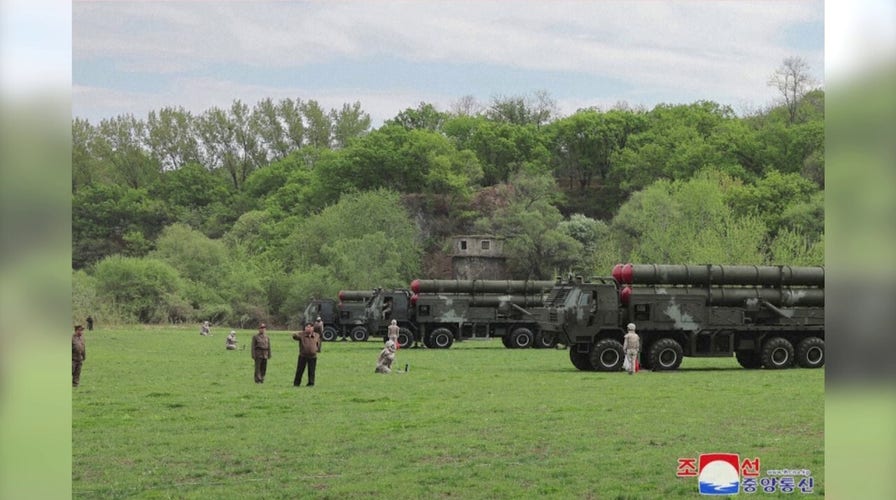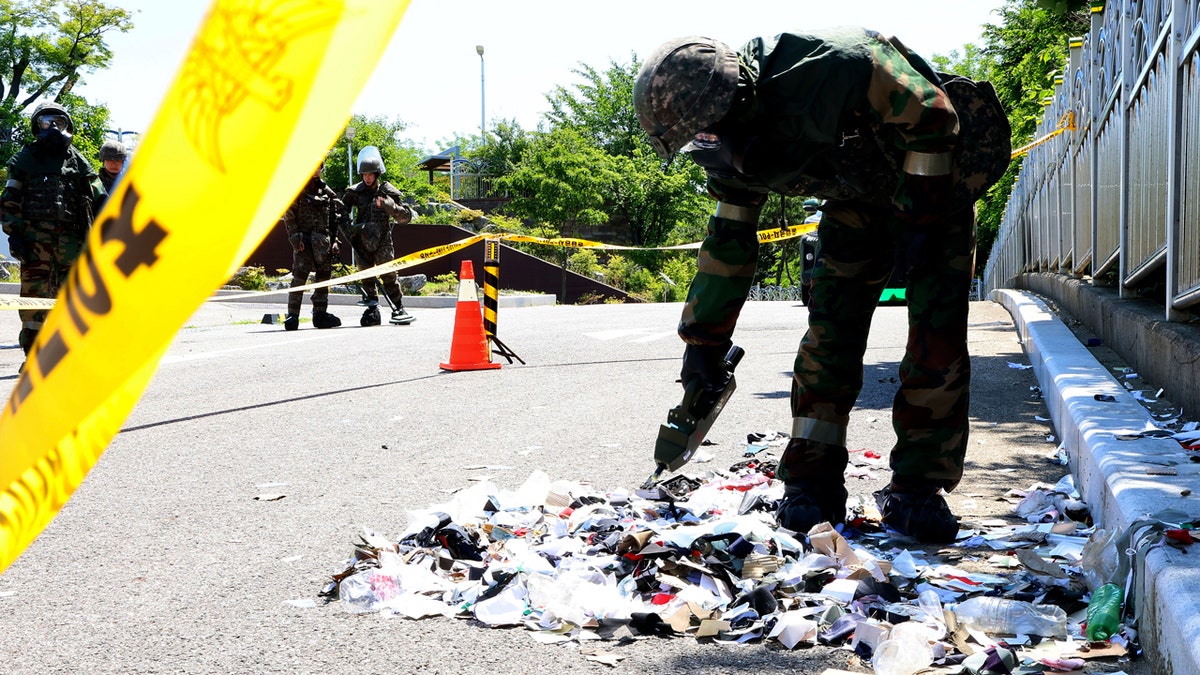close 
Kim Jong Un oversees North Korean nuclear arsenal
Korth Korean leader Kim Jong Un views a simulated nuclear counterattack drill. (Credit: Associated Press)
- South Korea is watching for possible new launches of North Korean balloons carrying trash as tensions escalate between the neighboring countries.
- Last week, North Korea sent about 1,000 balloons carrying manure and garbage across the border into South Korea following South Korean activists sending their own balloons carrying political leaflets to the North.
- North Korea’s vice defense minister said his country would stop the balloon campaign but threatened to resume it if South Korean activists sent leaflets again.
South Koreans were alert Friday for possible new launches by North Korea of balloons carrying rubbish into the South, a day after Seoul activists flew their own balloons to scatter political leaflets in the North.
Any resumption of trash balloon launches by North Korea would likely prompt South Korea to respond, possibly with anti-North Korean loudspeaker broadcasts or live-fire exercises along their heavily fortified border. North Korea would probably retaliate with its own measures, further escalating tensions between the rivals.
Here is a look at the soaring animosities between the Koreas over the balloon launches:
US CONDUCTS FIRST PRECISION BOMBING DRILL WITH SOUTH KOREA IN 7 YEARS AS TENSIONS WITH NORTH KOREA RISE
WHY ARE THE KOREAS WRANGLING OVER BALLOONS?
Last week, South Korean authorities discovered about 1,000 North Korean-flown balloons carrying manure, cigarette butts, scraps of cloth, waste batteries and vinyl in various parts of South Korea. No highly dangerous materials were found, but some South Koreans worry that North Korea may launch balloons with biological or other hazardous materials in the future.
South Korean officials called the North Korean balloon campaign and other recent provocations “absurd, irrational” and vowed “unbearable” retaliation. They suspended a 2018 military agreement on easing frontline military tensions with North Korea.
Kim Yo Jong, the powerful sister of North Korean leader Kim Jong Un, said the balloons were a response to campaigns by South Korean civilians to fly propaganda leaflets into North Korea. Analysts say the North’s action was also likely designed to trigger a divide in South Korea over its conservative government’s tough policy on North Korea.

A South Korean soldier wearing protective equipment inspects the trash from a balloon presumably sent by North Korea, in Incheon, South Korea, on June 2, 2024. (Im Sun-suk/Yonhap via AP, File)
For years, South Korean civic activists have used helium-filled balloons to drop anti-North Korean leaflets and USB sticks with South Korean dramas and world news in the North, which forbids access to foreign news for most of its 26 million people. The launches infuriate North Korea, which has previously fired at the balloons and destroyed an empty South Korean-built liaison office in the North in response.
ARE THE TENSIONS OVER BALLOONS LIKELY TO RISE?
North’s vice defense minister, Kim Kang Il, said Sunday that his country would stop the balloon campaign but threatened to resume it if South Korean activists sent leaflets again.
In defiance of the warning, a South Korean civilian group led by North Korean defector Park Sang-hak said it launched 10 balloons from a border town on Thursday carrying 200,000 anti-North Korean leaflets, USB sticks with K-pop songs and South Korean dramas, and one-dollar U.S. bills.
“We sent the truth and love, medicines, one-dollar bills and songs. But a barbaric Kim Jong Un sent us filth and garbage and he hasn’t made a word of apology over that,” Park said.
North Korea hasn’t immediately responded. Many experts predict it will resume flying trash-carrying balloons when weather conditions are favorable. North Korea’s state media have previously called Park “human scum without an equal in the world.”
Following the suspension of the 2018 tension-easing agreement, South Korea is ready to retaliate against a new North Korean balloon campaign by restarting frontline live-fire drills or loudspeaker broadcasts of anti-North Korean messages and outside news. Such steps are likely to further enrage North Korea.
IS COLD WAR-STYLE PSYCHOLOGICAL WARFARE RETURNING?
Flying balloons with propaganda leaflets into each other’s territory was one of the most common psychological campaigns by the two Koreas during the 1950-53 Korean War and at the height of the Cold War.
But the North Korean balloons sent into South Korea in recent days carried only garbage, not political leaflets. It was the North’s first balloon campaign in seven years.
In a Memorial Day speech Thursday, South Korean President Yoon Suk Yeol said that “North Korea carried out a despicable provocation that would make any normal country ashamed of itself.” U.S. State Department spokesperson Matthew Miller earlier called the trash-carrying balloons “disgusting” and “childish.”
Frontline loudspeaker broadcasts were also used by the rival Koreas for psychological warfare during the Cold War, along with giant frontline billboards and propaganda radio broadcasts.
CLICK HERE TO GET THE FOX NEWS APP
In recent years, the two Koreas have agreed to halt such activities but sometimes resumed them when tensions rose. South Korean officials say they have no legal grounds to ban private citizens from flying balloons to North Korea, after the country’s constitutional court last year struck down a law criminalizing such leafleting as a violation of free speech.
Many in South Korea believe a resumption of loudspeaker broadcasts would severely sting North Korea’s leadership because of fears the broadcasts would demoralize frontline troops and residents of the rigidly controlled society and eventually weaken Kim Jong Un’s leadership.
In 2015, when South Korea restarted loudspeaker broadcasts after a lapse of 11 years, North Korea fired artillery rounds across the border, prompting South Korea to return fire. No casualties were reported.
